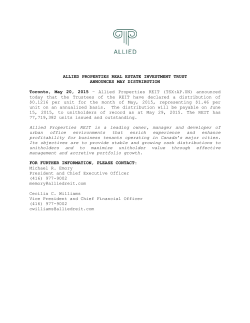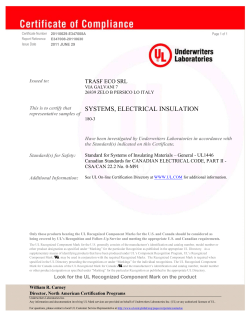
PDF - Faircourt Asset Management
FAIRCOURT SPLIT TRUST Inception Date: March 17, 2006 Fund Manager: Faircourt Asset Management Inc. Portfolio Advisor: Faircourt Asset Management Inc. TSX Symbols: FCS.UN & FCS.PR.C Faircourt Split Trust was created using a dual security structure, consisting of Trust Units and Preferred Securities, to provide investors with leveraged capital growth potential based on a portfolio of North American equity securities. TOP TEN HOLDINGS as at March 31, 2015 •Agrium Inc. •Altria Group Inc. •Badger Daylighting Ltd. •Boyd Group Income Fund •Canadian Apartment Properties REIT •Dollarama Inc. •Easyhome Ltd. •Fairfax Financial Holdings Ltd. •Milestone Apartments REIT •Secure Energy Services Inc. of the original subscription price to Unitholders, the original subscription price of the Preferred Securities.** The investment objectives with respect to the Trust Units are: (a) to provide Unitholders with a stable stream of tax efficient monthly cash distributions currently $0.02 per Trust Unit per month to yield 4.10% (market price as at March 31, 2015), a portion of which is tax-deferred; and (b) to return to Unitholders, on December 31, 2019 at least the original subscription price of the Units. The following shows the returns since the merger for the trust units ending March 31, 2015. The returns are calculated in Canadian dollars. PERFORMANCE SINCE SEPTEMBER 30, 2010 PAST PERFORMANCE The Benchmark for the Fund is composed of the S&P TSX Composite Index (weight of 70%) and the S&P 500 in Cdn dollars (weight of 30%) PORTFOLIO ALLOCATION Utilities, 7.1% First Quarter 2015 Cash and Cash Equivalents, 8.6% Telecommunications, 2.7% Consumer Discretionary / Staples, 18.5% Real Estate Investment Trusts, 16.5% Convertible Debentures, 0.9% Materials, 6.6% Energy, 1.2% Information Technology, 1.3% Financials, 17.1% Industrials, 15.1% Healthcare, 4.3% Based on % of Portfolio, Net of Options Source: Bloomberg. Data is based on price and includes distributions. Investment Objectives The investment objectives of the Trust are to achieve a balance between the objectives of the Preferred Securityholders and Unitholders, subject to the prior rights of Preferred Securityholders. The investment objectives with respect to the Preferred Securities are (i) to provide Securityholders priority distributions of interest in the amount of $0.15 per quarter ($0.60 per annum to yield 6.0% per annum on the subscription price of $10.00); and (ii) to repay to Preferred Securityholders, on June 30, 2019 in priority to any return Returns for the period ended March 31, 2015 1 Year 3 Year FCS Price(1) FCS NAV(1,3) FCS Index (2) -2.77% -2.77% 13.66% 3.90% 3.05% 14.39% *Since Inception 9.76% 7.27% 11.74% Notes: (1) Assumes reinvestment of distributions; (2) Source: Bloomberg (3) Based on Basic NAV; Source: Faircourt Asset Management *FCS since inception is from period September 30, 2010 (Date of merger with FIG) **Preferred Securities have been refinanced at 6% effective December 31, 2014, maturing June 30 2019 FAIRCOURT Asset Management Inc. 141 Adelaide St. West, Suite 1402, Toronto, Ontario, M5H 3L5 416.364.8989 Toll Free: 1.800.831.0304 Fax: 416.360.3466 www.faircourtassetmgt.com Copyright © 2005–2010 Faircourt Asset Management Inc. All rights reserved. Management fees and expenses are associated with an investment in the fund. The performance data provided assumes reinvestment of distribution only and does not take into account redemption charges or income taxes payable by any security holder that would have reduced returns. An investment in the fund is not covered by the Canada Deposit Insurance Corporation or any other government deposit insurer. There can be no assurance that the fund will be able to maintain its net asset value per security at a constant amount or that the full amount of your investment in the fund will be returned to you. Past performance may not be repeated. FAIRCOURT SPLIT Faircourt Split Trust: March 2015 Update The first quarter of 2015 witnessed continued strength in the US dollar, along with slower growth and mixed economic results that continue to plague the US economic recovery. Canadian economic results were hard hit by the continued weakness in energy prices, resulting in a weaker jobs market and softer overall equity values for the TSX, as financials were brought down by their lending exposure to the energy sector. As a result, North American equity markets provided subdued returns relative to recent quarterly results. In early 2015 currency markets have become more volatile as changes in policy direction among Central Banks have created division among different countries. Most notably, the U.S. Federal Open Market Committee (“FOMC”) and its focus on a growing US economy and the need for higher interest rates at a time when other Central Banks such as those from China and the European Union have had to focus on lower interest rates and increased stimulus. The divergence in policy goals has created a strong US dollar that now poses a headwind for some US equities. With forty percent of profits from S&P 500 companies emanating from foreign markets, US dollar strength reduces that portion of earnings coming from outside the US. Our management team believes that a key factor for US Fed officials and the basis for an interest rate increase is wage growth. Federal Reserve officials are still seeing slow jobs growth, however as wage growth continues, it is a barometer for the Fed as to when to begin the move toward more normalized rates. During Q1 real average hourly earnings grew an estimated 1.5% over Q4 of 2014. The US economy has grown 0.4% over that same period, so aggregate spending power among US workers has gone up however those improvements have not yet been reflected in consumption patterns. Consumer confidence remains less than exemplary. The fall in oil prices since last summer is positive for the overall US economy, transferring income from oil producers to retail consumers. The average US household will save roughly $900 at the pumps over the next year offering consumers more for consumption and savings. However as the price of oil has dropped there has also been a reduction in energy related jobs which will reduce GDP growth. Although hourly wages are improving, jobs numbers in Q1 were lacklustre. During the first quarter, monthly jobs numbers were subdued and the US economy added 201k jobs in January, 129k in February and only 126k jobs in March. All the more worrisome was that these results were compared to the 6 month average labor results of 281k. The first quarter misses were the largest discrepancies in results since December 2009. As a result of the weakness market forecasters have adjusted US GDP growth down for the year and the Fed’s 2% GDP growth target seems difficult to achieve. We continue as a result to believe that the US Federal Reserve will need to remain accommodative until such time as employment and confidence in the economy is more robust. The Canadian economy and the S&P/TSX suffered in Q1 due to the drop in oil prices that affected equity values, consumer confidence and jobs growth. Lower oil prices were weighing on the Canadian economy with reduced business investment, reduced rig counts, and resulting reduced employment opportunities in the oil patch. Also experiencing negative pressure in Q1 was overall equity market strength as two key sectors on the TSX, energy and financials, suffered due to direct and indirect exposure to reduced oil prices. Canadian Banks were facing downgrades from US analysts as lending exposure was cited as a limit on upcoming quarterly earnings. The expectation is that Canada will see weaker corporate profits over the next few quarters. These negatives are partially offset by the anticipated savings that that the weaker energy market will provide Canadians over the next 24 months. As a result of the subdued growth witnessed in Canada, Governor of the Bank of Canada Stephen Poloz has stated that interest rates will remain low for an extended period which will continue to benefit home owners and consumers. As interest rates remain low, the central bank will provide additional stimulus for Canadians to adjust to the slow but gradual growth in the economy. In addition, as Canada is an export led economy, a weakened Canadian dollar relative to the US, where the bulk of our trade is conducted will lead to stronger export led growth. Further with the drop in energy prices, consumers in Canada will benefit with households having additional savings from lower prices at gas pumps. The Fund portfolio uses a diversified approach to North American equities, maintaining exposure in many of the sub-sectors within the S&P/TSX and S&P 500. In order to generate additional returns and reduce risk, the Fund may write covered calls on securities held in the portfolio and cash secured put options on securities desired to be held in the portfolio. The Fund will continue to focus on holding a diversified portfolio of leading companies, many of which generate stable and growing distributions. Criteria we look for are sound business models, steady demand for products or services, growing positive cash flow, minimal need for debt or need to raise significant amounts of capital as well as having a lower dividend payout ratio. These metrics allow the company ample operating room to pay the dividend and/or repurchase shares in the event of an unexpected slowdown. Core positions such as Fairfax Financial, Dollarama, Boyd Group, and Easyhome Ltd., continue to grow the NAV of the Fund and will continue to make up a healthy weighting in the portfolio going forward. Dollarama Inc., the largest operator of dollar stores in Canada, returned 19% during the quarter. All stores are corporate owned and offer consumers a strong value proposition at select fixed price points of $3 or less. Boyd Group Income Fund, a North American auto-body repair company has generated excellent growth over the past several years, was up 12% in the first quarter of 2015. We continue to see attractive organic growth in Easyhome as it expands its personal loan business. Easyhome was up 2% during the quarter. Real estate investment trusts and pipeline equities continue to benefit from the low interest rate environment we are in. Both sectors benefit from lower cost of capital and as such, the improved cash flow should allow for increased dividend and distribution payments to shareholders. We have added to our REIT holdings overall, more specifically to Canadian Apartment REIT and Milestone Apartment REIT. Canadian Apartment REIT and Milestone REIT were up 17% and 16% in the quarter. Our largest fund holding is in Fairfax Financial that, through its subsidiaries, is engaged in property and casualty insurance, reinsurance and investment management. Its investment/hedging strategies and financial acumen differentiate the company from most financial service businesses, producing stable returns over the long term. Fairfax returned 19% during the quarter, easily outperforming the S&P/TSX Financials Index by 19x. Another holding we have been adding to over time is Alaris Royalty. Alaris provides capital to private businesses using a structure that fills the niche in the private capital markets and in return they receive royalty payments. We expect a busy 2015 as there is strong pipeline of private companies interested in Alaris’s capital as well as the continued opportunity for follow-ons with existing partners. The Fund will also continue to employ its option-writing program to provide income to the Fund while reducing the volatility of the portfolio. The Fund generated significant cash flow from option writing of approximately $239,000 or $0.15 per weighted average number of Trust Units outstanding during the period ended March 31, 2015. The Fund declared regular monthly distributions totalling $0.06 per Trust Unit in the period. Since inception of the option-writing program in 2009, the Fund has generated significant cash flow from option premium of approximately $7.90 million or $2.91 per weighted average number of Trust Units outstanding. As volatility has returned to heightened market levels, the Manager continues to believe that option writing can add incremental value going forward. For the quarter ending March 31, 2015, the Fund outperformed the benchmark with the NAV of the Trust Units, combined with paid distributions during the quarter providing a total return for holders of Trust Units of 12.54%, results that significantly outperformed the blended benchmark return of 4.92%
© Copyright 2025















